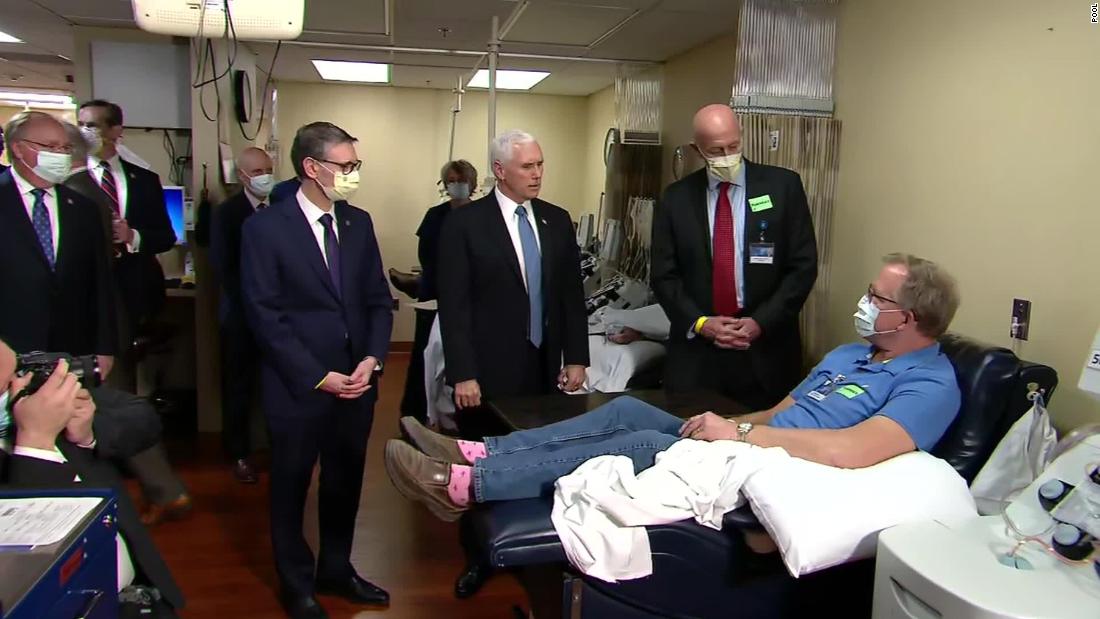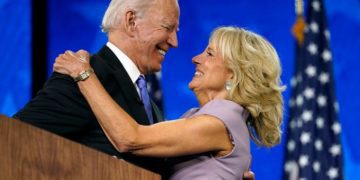[ad_1]
On Wednesday, he downplayed the edict and mused that maybe blanket testing wasn’t necessary as states move to reopen.
“You’ll see some astonishing numbers — I don’t know that all of that’s even necessary,” Trump said of nationwide testing efforts during an event at the White House. “You have some governors that love the tests, you have others that like doing it a different way, an old-fashioned way, with some testing.”
The comments — contradicting his own administration’s previous guidance and rebutting the expertise of health officials — were the latest in a string of confusing steps that appear to pit Trump against his own advice as he pivots to a post-pandemic American revival.
While never meant as compulsory measures, the various playbooks offered by the administration on how to safely return to normal have been flouted by Trump and his team in some settings even as they encourage their use in others.
The same guidelines indicate non-essential travel should be limited until another sustained period of declining cases passes — but Trump says he’s going to Arizona next week and hopes to visit Ohio shortly.
The dissonance between the official guidelines and the presidential messaging has confused some governors and, at certain moments, obscured the administration’s own intended storyline. As Trump looks ahead to his reelection in November, aides say he is intent on salvaging a cratering economy and insistent on projecting victory but cautious at being blamed should coronavirus surge again — a conflicting mindset that has led to a similarly conflicting public stance.
At the same time, Trump and his senior advisers — including his son-in-law Jared Kushner — continue to chafe at not getting enough credit for their efforts in combating the coronavirus. Kushner has privately expressed frustration in recent days that he and the administration overall aren’t getting enough credit for their efforts regarding the outbreak, two people aware of his comments told CNN.
With a new set of guidelines being finalized on how to reopen certain types of establishments, such as restaurants and schools, the White House will face another opportunity to streamline how it thinks America should return to normal. The new recommendations come after major business groups urged the administration to offer uniform guidance to states on how to reopen the types of places that have been shuttered during the pandemic.
While the White House issued a three-phase blueprint for reopening states earlier this month, it did not contain specific recommendations like altering floor plans or reducing capacity inside establishments where social distancing was once impossible. Already, Trump has faced intense lobbying from industry groups who want to have a say in what the White House recommends, fearful the new guidelines could further affect their bottom lines.
The CDC has drafted guidance that includes recommendations like limiting seating capacity in restaurants. But even before the new guidelines are issued, it’s clear Trump is envisioning a reopening that looks more akin to pre-pandemic life.
“I had one restaurant owner come up to me and said, ‘Sir, you know I’m going to be opening up, but if I distance too much I have 50% of the restaurant I had,’ ” Trump said during a meeting with industry leaders on Wednesday. “And I said, ‘You’ll also have a worse atmosphere.’ “
“We want it to be the way it was,” he said.
Unsteady guidance
Even the social distancing guidelines offered by the White House more than a month ago have been unsteadily adhered to by the President, who still regularly meets with staff and visitors in person at the White House, often without 6 feet of separation. While he is tested weekly, and those who interact with him are tested before meetings, he has hardly sought to model the behaviors his administration has recommended for other Americans during the pandemic.
The current guidelines, Pence said on Wednesday during a meeting in the Oval Office, are “very much incorporated in the guidance that we’re giving states to open up America again.”
But confusing matters, Trump chimed in to explain the current guidelines will be “fading out” as states begin to reopen.
“I am very much in favor of what they’re doing,” Trump said of governors who are opening businesses. “They’re getting it going.”
Still, right now it does not appear that any state meets the vague, advisory White House guidelines that call for a “downward trajectory of documented cases within a 14-day period” before any opening. When presenting the guidelines, the administration wasn’t clear whether a state required 14 consistent days of decrease, or whether a single day of increased cases would force a state to begin the 14-day period over, even if the overall line is trending down.
In Texas, Republican Gov. Greg Abbott announced a plan this week that would allow restaurants, movie theaters and malls to begin readmitting customers at a quarter capacity as long as they enforce social distancing guidelines. The stay-at-home order he enacted a month ago will also expire. But cases in the state have not been steadily decreasing over the past 14-days, according to figures from the state’s Department of State Health Services.
Nevertheless, Trump congratulated Abbott on Twitter this week, writing he was doing a “great job” in beginning his state’s phased reopening. He similarly encouraged Florida’s Republican Gov. Ron DeSantis on his efforts to reopen portions of his state, even as case counts there have increased on certain days. The state reported 708 new cases of Covid-19 on Tuesday, the highest figure the state has reported in the past three days. Overall, however, the state’s daily case counts have trended down since earlier in the month.
But Trump offered a bullish projection on the state’s plans to reopen, which DeSantis planned to unveil in more detail on Wednesday. “He’s going to be opening up large portions and, ultimately, pretty quickly, because he’s got great numbers,” Trump said.
Trump is eager for states to begin lifting stay-at-home orders as dire economic news floods in. More bleak numbers arrived Wednesday when the government said US GDP contracted by a 4.8% annualized rate during the first quarter. It was the US economy’s worst quarter since late 2008. Trump has encouraged protesters in states seeking to “liberate” themselves from stay-at-home orders and this week Attorney General William Barr told federal prosecutors across the country to be on guard for overbearing state and local coronavirus measures.
Members of Trump’s task force have been more vocal in advising states to adhere to the federal guidelines.
“Hopefully everyone does it according to the Guidelines for Opening America, which were very carefully designed and which I played a role in making very conservative and very careful,” Dr. Anthony Fauci, the nation’s top infectious disease expert, said during a conversation with the Economic Club of Washington on Tuesday.
Fauci and other members of Trump’s task force have said repeatedly that increasing testing will be paramount to any reopening efforts and laid out a plan this week that places most of the onus on individual states and the private sector for increasing capacity.
Trump has bristled recently when questioned on the testing shortfalls, which he insists have been remedied. He has told reporters they should be more favorable in their coverage of the testing issue — a sentiment that others in the White House have echoed.
More credit?
Kushner in particular has said the public-private sector mobilization on supplies that he helped spearhead hasn’t gotten enough credit, nor have the efforts to ramp up ventilator production. Despite rarely appearing on television, Kushner has sat down with Fox News twice this week to tout the White House’s efforts. A person close to Kushner said his appearances were encouraged by the President, who noted he knows the subject matter well.
On Fox News Wednesday, Kushner described how the federal government “rose to the challenge” and was “a great success story.” When he was pressed on testing levels, Kushner said the question shouldn’t be why did it take so long, but “how did we do this so quickly?”
“What’s really happened, it’s really extraordinary,” he added. His father-in-law seemed to note his frustration. In the Oval Office a few hours later, he called Kushner “a genius.”
Still, the self-congratulations haven’t necessarily led to any greater clarity on how states should reopen. Even Trump’s application of pressure on governors has not been consistent. Last week, after Georgia Republican Gov. Brian Kemp announced a plan allowing businesses like nail salons and bowling alleys to reopen, Trump initially told him on a telephone call he supported the plan.
But after members of Trump’s coronavirus task force — principally Dr. Deborah Birx, the White House coronavirus response coordinator — cautioned that Georgia’s reopening plans were not in keeping with the federal guidelines Trump had unveiled a few day earlier, he reversed course and stated publicly he disagreed “strongly” with the plans.
Trump, speaking during a news conference, said specifically the plans “are in violation of the phase one guidelines.” Later, he said he would intervene in other states’ reopening plans only if he saw “something totally egregious.”
The comply-if-you-want attitude has also governed Trump’s approach toward face masks, which were initially discouraged by his administration but later recommended as a way for asymptomatic people with coronavirus to avoid spreading it.
When he initially read out the new recommendations from the CDC, Trump immediately declared he wouldn’t wear one himself, saying it was impossible to imagine greeting world leaders in the Oval Office with his face covered.
Pence appeared to adopt the same attitude on Tuesday when he visited the Mayo Clinic in Minnesota, which has required all visitors to wear a mask since April 13.
Despite his staff being made aware of the policy ahead of time, and having masks offered to him and his team when they arrived, Pence toured the facility bare-faced — a striking contrast in photos when every other person in the building, including administration officials, was seen with their face covered.
Aides recognized afterward that the point of the visit — to showcase research efforts on convalescent plasma — were overshadowed by the mask controversy. But it wasn’t the first time Pence found himself without a mask when others were covering their noses and mouths. When he visited Colorado last week, he was greeted on the tarmac by Democratic Gov. Jared Polis, who was wearing a cloth mask with the state’s logo printed on it.
In explaining himself, Pence said he is tested regularly for coronavirus and was adhering to the CDC guidelines, which say masks help prevent people who have the disease from spreading it. And he proclaimed a desire to look clinic workers “in the eye and say thank you,” though masks do not generally obscure the eyes.
CNN’s Kaitlan Collins contributed to this report.
CORRECTION: This story has been updated to accurately reflect when Trump instructed states to maximize testing


















